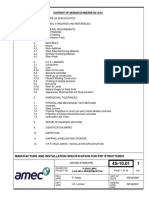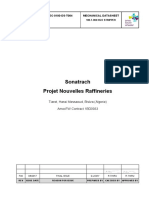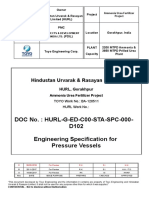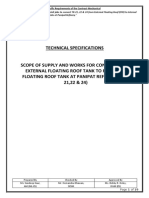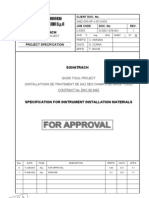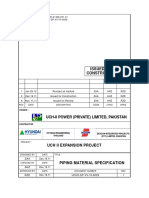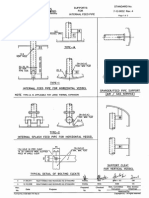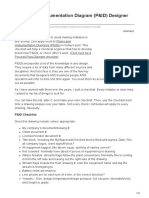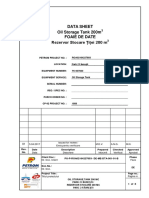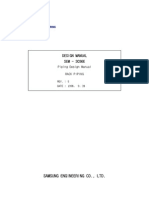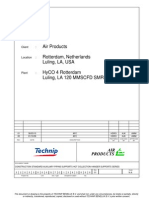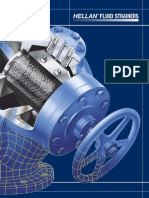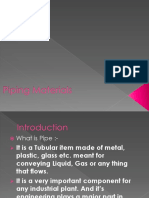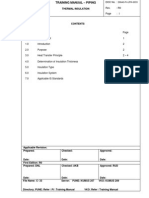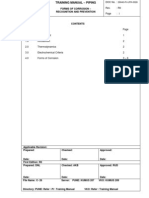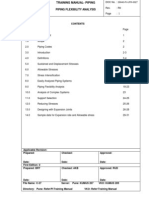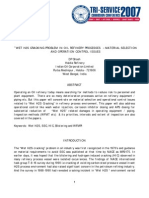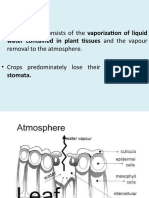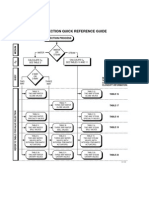0 ratings0% found this document useful (0 votes)
473 viewsSMPV
SMPV
Uploaded by
Prasanta Kumar BeheraThis document outlines safety guidelines for the storage of compressed gases in pressure vessels according to the Static and Mobile Pressure Vessel (Unfired) Rules, 1981. Some key points:
- Pressure vessels must be located outdoors, above ground, and at a minimum distance from buildings and other vessels depending on the vessel size and gas type.
- Flammable, corrosive, and toxic gases have greater minimum separation distances than non-toxic gases.
- The area where vessels are located must be enclosed by an industrial fence at least 2 meters high and have at least two exits.
- Structural supports for vessels must be encased in fire-resistant materials above 45 cm, and an area of 3
Copyright:
© All Rights Reserved
Available Formats
Download as PDF, TXT or read online from Scribd
SMPV
SMPV
Uploaded by
Prasanta Kumar Behera0 ratings0% found this document useful (0 votes)
473 views8 pagesThis document outlines safety guidelines for the storage of compressed gases in pressure vessels according to the Static and Mobile Pressure Vessel (Unfired) Rules, 1981. Some key points:
- Pressure vessels must be located outdoors, above ground, and at a minimum distance from buildings and other vessels depending on the vessel size and gas type.
- Flammable, corrosive, and toxic gases have greater minimum separation distances than non-toxic gases.
- The area where vessels are located must be enclosed by an industrial fence at least 2 meters high and have at least two exits.
- Structural supports for vessels must be encased in fire-resistant materials above 45 cm, and an area of 3
Original Description:
smpv
Original Title
smpv
Copyright
© © All Rights Reserved
Available Formats
PDF, TXT or read online from Scribd
Share this document
Did you find this document useful?
Is this content inappropriate?
This document outlines safety guidelines for the storage of compressed gases in pressure vessels according to the Static and Mobile Pressure Vessel (Unfired) Rules, 1981. Some key points:
- Pressure vessels must be located outdoors, above ground, and at a minimum distance from buildings and other vessels depending on the vessel size and gas type.
- Flammable, corrosive, and toxic gases have greater minimum separation distances than non-toxic gases.
- The area where vessels are located must be enclosed by an industrial fence at least 2 meters high and have at least two exits.
- Structural supports for vessels must be encased in fire-resistant materials above 45 cm, and an area of 3
Copyright:
© All Rights Reserved
Available Formats
Download as PDF, TXT or read online from Scribd
Download as pdf or txt
0 ratings0% found this document useful (0 votes)
473 views8 pagesSMPV
SMPV
Uploaded by
Prasanta Kumar BeheraThis document outlines safety guidelines for the storage of compressed gases in pressure vessels according to the Static and Mobile Pressure Vessel (Unfired) Rules, 1981. Some key points:
- Pressure vessels must be located outdoors, above ground, and at a minimum distance from buildings and other vessels depending on the vessel size and gas type.
- Flammable, corrosive, and toxic gases have greater minimum separation distances than non-toxic gases.
- The area where vessels are located must be enclosed by an industrial fence at least 2 meters high and have at least two exits.
- Structural supports for vessels must be encased in fire-resistant materials above 45 cm, and an area of 3
Copyright:
© All Rights Reserved
Available Formats
Download as PDF, TXT or read online from Scribd
Download as pdf or txt
You are on page 1of 8
TRAINING MANUAL- PIPING
STATIC AND MOBILE PRESSURE
VESSEL (UNFIRED) RULES, 1981
Uhde India Limited
DOC No. : 29040-PI-UFR-0022
Rev. : R0
Page : 1
CONTENTS
Page
0.0 Cover Sheet 1
1.0 Introduction 2
2.0 Definitions 2 3
3.0 General Exemptions 3
4.0 Restriction on Filling and Manufacture 3
5.0 Design Code 3
6.0 Storage 3 5
7.0 Fire Proofing on Structural Support 5
8.0 Fencing 5
9.0 No Smoking 5
10.0 Earthing 6
11.0 Fire Protection 6
12.0 Hoses 6
13.0 Vehicle Parking 6
14.0 Licence for Storage of Compressed Gas 7
15 General Points 7 8
Applicable Revision:
Prepared:
Date:
Checked:
Date:
Approved:
Date:
First Edition: R0
Prepared: DNL
Date:
Checked: AKB
Date:
Approved: RUD
Date:
File Name: C- 22 Server: PUNE: KUMUS 207 VKO: KUMUS 209
Directory: PUNE: Refer \ Pi \ Training Manual VKO: Refer \ Training Manual
TRAINING MANUAL- PIPING
STATIC AND MOBILE PRESSURE
VESSEL (UNFIRED) RULES, 1981
Uhde India Limited
DOC No. : 29040-PI-UFR-0022
Rev. : R0
Page : 2
1.0 INTRODUCTION:
Given below is an extract from Static and Mobile Pressure Vessels (Unfired) Rules with
explanation added wherever necessary. However, for further details refer Act/Rules. The
approving authority is Chief Controller of Explosives, Nagpur.
2.0 DEFINITIONS:
Compressed gas means any permanent gas, liquefiable gas or gas dissolved in liquid,
under pressure or gas mixture, which in a closed pressure vessel exercises a pressure
either exceeding two atmospheres (gauge) at the maximum working temperature and
includes Hydrogen Fluoride. In case of Vessels without insulation or refrigeration the
maximum working temperature shall be considered as 55
O
C.
Filling density means the ratio of weight of liquefiable gas allowed in a pressure vessel
to the weight of water that the vessel will hold at 15 degree C.
Flammability range means the difference between the minimum and maximum
percentage by volume of the gas in mixture with air that forms a flammable mixture at
atmospheric pressure and ambient temperature.
Flammable compressed gas means gas 13 percent or less of which when mixed with air
forms a flammable mixture or whose flammable range with air is greater than 12 percent.
Installation means any place which has been specially prepared for the storage of
compressed gas in pressure vessels.
Liquefiable gas means any gas that may be liquefied by pressure above 0
O
C but will be
completely vaporised when in equilibrium with normal atmospheric pressure (760 mm Hg)
at 30 degree C.
Permanent gas means a gas whose critical temperature is lower than 10
O
C.
Pressure vessel means any closed metal container of whatever shape, intended for the
storage and transport of any compressed gas which is subjected to internal pressure and
whose water capacity exceeds one thousand litres and includes interconnecting parts and
components thereof upto the first point of connection to the connected piping and fittings,
but does not include containers wherein steam or other vapour is, or is intended to be
generated, or water or other liquid is, or is intended to be heated by the application of fire,
or the products of combustion or by electrical means, heat exchangers, evaporators, air
receivers, steam type digestors, steam type sterilizes, autoclaves, reactors, calorifiers and
pressure piping components, such as separators or strainers, and vessels containing a
liquid under a blanket of compressed inert Gas.
Source of ignition means naked lights, fires, exposed incandescent materials, electric
welding arcs, lamps, other than those specially approved for use in flammable
atmosphere, or a spark or flame produced by any means.
Transport means the transport of a pressure vessel filled with any compressed gas from
one place to another but does not include movement of the vessel from one place to
another in the same premises.
Vessel means a pressure vessel.
TRAINING MANUAL- PIPING
STATIC AND MOBILE PRESSURE
VESSEL (UNFIRED) RULES, 1981
Uhde India Limited
DOC No. : 29040-PI-UFR-0022
Rev. : R0
Page : 3
Water capacity means capacity in litres of the pressure vessel when completely filled
with water at 15 degree C.
Critical temperature means the temperature above which gas can not be liquefied by the
application of pressure alone.
Dissolved gas means a gas which under pressure is dissolved in a fluid solvent
appropriate to the particular gas as for e.g. ammonia in water, acetylene in acetone.
Low pressure liquefiable gas means a liquefiable gas having critical temperature higher
than 70 degree C.
High pressure liquifiable gas means a liquefiable gas having a critical temperature
between -10 degree C and +70 degree C.
Gas cylinder means any closed metal container intended for the storage and transport
of compressed gas, designed not to be fitted to a special transport or under carriage and
having a volume exceeding 500 ml. but not exceeding 1000 litres.
3.0 GENERAL EXEMPTIONS:
Nothing in these rules shall apply to vessels which form part of a processing plant (Refer Rule
3.0 of SMPV Rules).
4.0 RESTRICTION ON FILLING AND MANUFACTURE:
No person shall fill any compressed gas in any vessel or transport any vessel filled with any
compressed gas unless such vessel has been manufactured in accordance with a type or
standard or code duly approved by the Chief Controller.
5.0 DESIGN CODE:
Vessels shall be designed, constructed and tested in accordance with the Indian Standard
2825; as amended from time to time, or such other standard or code approved by the
Chief Controller.
A test and inspection certificate issued by the manufacturer of the vessel duly
countersigned by an Inspector that the vessel meets with the requirements of the
standard or code referred to in sub rule (1) shall be furnished to the Chief Controller.
6.0 STORAGE:
The licensed premises shall not be used for any purpose other than storage and transfer
of compressed gas and purposes directly connected therewith.
Every vessel shall be outside any building and shall be supported on well designed
foundations.
All vessels meant for storage of compressed gas shall be installed entirely above ground,
that is to say, no part of the vessel shall be buried below the ground level.
TRAINING MANUAL- PIPING
STATIC AND MOBILE PRESSURE
VESSEL (UNFIRED) RULES, 1981
Uhde India Limited
DOC No. : 29040-PI-UFR-0022
Rev. : R0
Page : 4
Vessels and first stage regulating equipment shall be located in the open.
Vessels shall not be installed one above the other.
Vessels within a group shall be so located that their longitudinal axes are parallel to each
other.
No vessel shall be located within the bounded area of petroleum or other flammable liquid
storage.
Sufficient space shall be provided between two vessels to permit fire fighting operations.
Two or more vessels interlude in batteries shall be so installed that the top surface of the
vessels are on the same plane.
Vessels installed with their dished ends facing each other shall have screen walls in
between them.
Location of pressure vessels
Each vessel shall be located with respect to the nearest building or group of buildings or line
of adjoining property which may be built on and with respect to other vessels in accordance
with the distances specified in the Tables below:
TABLE 1 (Refer Chapter III, Rule 22)
MINIMUM SAFETY DISTANCES FOR FLAMMABLE, CORROSIVE AND TOXIC GASES
Sr.
no.
WATER CAPACITY OF
VESSEL(IN LITRES)
MIN. DISTANCE FROM
BLDG. OR GROUP OF
BLDGS. OR LINE OF
ADJ OINING PROPERTY
MIN.
DISTANCE
BETWEEN
PRESSURE
VESSELS
1. Not above 2000 5 metres 1 metre
2. Above 2000 but not above
10,000
10 metres 1 metre
3. Above 10,000 but not above
20,000
15 metres 1.5 metres
4. Above 20,000 but not above
40,000
20 metres 2 metres
5. Above 40,000 30 metres 2 metres
TRAINING MANUAL- PIPING
STATIC AND MOBILE PRESSURE
VESSEL (UNFIRED) RULES, 1981
Uhde India Limited
DOC No. : 29040-PI-UFR-0022
Rev. : R0
Page : 5
TABLE 2 (Refer Chapter III, Rule 22)
MINIMUM SAFETY DISTANCES FOR NON TOXIC GASES
SR.
NO.
WATER CAPACITY OF
VESSELS (IN LITRES)
MIN. DISTANCES FROM
BLDG. OR GROUP OF
BLDGS OR LINE OF
ADJ OINING PROPERTY
MIN.
DISTANCE
BETWEEN
VESSELS
1. Not above 2000 3 metres 1 metre
2. Above 2000 but not
above 10,000
5 metres 1.5 metres
3. Above 10,000 but not
above 20,000
10 metres 2 metres
4. Above 20,000 15 metres Diameter of
larger vessel
A. If the aggregate water capacity of a multivessel installation is 40,000 litres or more, the
above minimum safety distances shall apply to the aggregate storage capacity.
B. The number of storage vessels in one installation shall not exceed six. In case there
are more than one installations, the safety distance between two installations shall be
the same as the distance between the vessels and the property line in accordance with
Table 1.
C. The distance specified under Table 1 and 2 are required to be measured from the
nearest point on the periphery of the vessel.
7.0 FIRE PROOFING ON STRUCTURAL SUPPORT:
For vessels having structural steel supports, such supports, excluding vessel saddles or
supporting feet 45 cm. or less in height, shall be encased in fire resisting materials of
adequate thickness.
8.0 FENCING:
The area where vessels, pumping equipment, loading and unloading facilities and direct
fired vaporizers are provided shall be enclosed by an industrial type fence at least 2
metres high along the perimeter of the safety zone.
Every fence shall have at least two means of exit and the gates of such exit shall open
outwards and shall not be self locking.
An area of three metres around the vessel shall be kept free from readily ignitable
materials, such as weeds and long dry grass. Also except for necessary pipes and valves
and approved electric lights the space within the licensed premises shall be kept entirely
clear and unoccupied.
9.0 NO SMOKING: (Rule 27)
A permanent Notice with letters at least 5 Cms. in height prohibiting smoking and naked
lights, shall be fixed to the fence surrounding the area where flammable or oxidising gases
are stored and the Notice shall be visible from outside.
TRAINING MANUAL- PIPING
STATIC AND MOBILE PRESSURE
VESSEL (UNFIRED) RULES, 1981
Uhde India Limited
DOC No. : 29040-PI-UFR-0022
Rev. : R0
Page : 6
10.0 EARTHING:
All vessels used for storage of flammable liquefiable gases shall be electrically connected
with the earth in an efficient manner.
Pipelines conveying flammable liquids shall be adequately prepared for electrical
continuity and connected with the earth in an efficient manner.
11.0 FIRE PROTECTION:
All vessels used for the storage of flammable compressed gases shall be protected against
fire hazards as under:
Provision shall be made for an adequate supply of water and fire protection in the storage
area according to the local fire service regulations. The application of water may be by
hydrants, hoses and mobile equipment, fixed monitors or by fixed spray systems which
may be automatic. Control of Water System which may be automatic, control of water
flow should be possible from outside any danger area;
Hydrants, where provided, shall be readily accessible at all times and so spaced as to
provide for the protection of all vessels;
Sufficient length of fire hose shall be provided and be readily available. The outlet of each
hose line shall be equipped with a combination jet and fog nozzle. The hoses should be
maintained well and periodically inspected;
Mobile equipment, fixed monitors or fixed spray systems shall be designed to discharge
water at a rate sufficient to maintain an adequate film of water over the surface of the
vessel and supports under fire conditions;
Consideration shall be given to the provision of mobile or fixed water spray systems giving
suitable and effective protection for vehicle loading and unloading areas;
At least two dry chemical powder type fire extinguishers of 9 kg. Capacity each shall be
installed at each point of access to the installations.
12.0 HOSES: (Refer Rule 29)
The hoses for liquid transfer shall be designed to withstand not less than four times the
maximum operating pressure they will carry in service:
The hoses shall be mechanically and electrically continuous.
13.0 VEHICLE PARRKING: (Refer Form III, Conditions No. 5)
A suitable hard stand for parking of the vehicle during loading or unloading of any
compressed gas shall be provided. A minimum safety distance of 9 metres shall be
maintained between -
a. The centre of the hard stand and the storage vessel;
b. The centre of the hard stand and the boundary line of the installation;
c. Loading or unloading points and storage vessel or boundary line.
TRAINING MANUAL- PIPING
STATIC AND MOBILE PRESSURE
VESSEL (UNFIRED) RULES, 1981
Uhde India Limited
DOC No. : 29040-PI-UFR-0022
Rev. : R0
Page : 7
14.0 LICENCE FOR STORAGE OF COMPRESSED GAS: (Refer Chapter V)
14.1 No person shall store any compressed gas in any vessel except under and in
accordance with the conditions of a licence granted under these rules.
14.2 Every person desiring to obtain a licence to store any compressed gas in any vessel
shall submit to the Chief Controller, specifications and plans drawn to scale in triplicate
clearly indicating
a. The manner in which the provisions prescribed in these rules shall be complied
with.
b. The premises proposed to be licensed, the area of which shall be distinctly coloured
or otherwise marked.
c. The surrounding area lying within 100 metres of the edge of all facilities which are
proposed to be licensed.
d. The position, capacity, materials of construction and ground and elevation views of
all vessels, all valves and fittings, filling and discharge pumps and fire fighting
facilities where provided and all other facilities forming part of the premises
proposed to be licensed.
14.3 If the Chief Controller after scrutiny of the specifications and plans and after making
such inquiries as he deems fit, is satisfied that compressed gas can be stored in the
premises proposed to be licensed, he shall return to the applicant one copy each of all
the specifications and plans signed by him conveying his sanction which may be subject
to such conditions as he may specify.
15.0 GENERAL POINTS:
Usually vessels are designed with minimum number of nozzles Towards this, normally
two or three manholes with blind covers are provided on top of the vessel. All piping and
instrument nozzles are located on these manholes. Usual practice is to locate all
instrument nozzles on one manhole and piping nozzles on other manhole.
An operating platform on top of the vessels is provided. With manholes located on either
sides of the platform. This platform serves the purpose of operating various valves and
access to instruments.
It is not recommended to take supports from the vessel for either supporting the platform
or for supporting the lines.
Platform is usually provided with a staircase.
Usually the lines connected to gas storage pressure vessels have slopes towards the
vessels. This usually calls for routing the lines on piperack within licensed premises.
Dished ends of vessels should preferably so located that their longitudinal axes do not
point towards
1. Process plant.
2. Any petroleum product storage tank within plant.
3. Any other pressure vessel located within plant and covered under SMPV rules.
TRAINING MANUAL- PIPING
STATIC AND MOBILE PRESSURE
VESSEL (UNFIRED) RULES, 1981
Uhde India Limited
DOC No. : 29040-PI-UFR-0022
Rev. : R0
Page : 8
This is to avoid construction of Blast proof walls otherwise between them.
SMPV rules permit loading/unloading of tankers within fenced area of storage. However,
loading/unloading of tonners/cylinders within fenced area of storage is not permitted. A
shed for filling or unloading of cylinders/tonners should be located outside the fenced area
of storage.
You might also like
- Attachment 53 - Standard Pipe Support Drawings For ReferenceDocument137 pagesAttachment 53 - Standard Pipe Support Drawings For ReferenceErman DurmazNo ratings yet
- SAMSUNG SEM-3069E Compressor & Turbine Piping Design Standard - 2Document34 pagesSAMSUNG SEM-3069E Compressor & Turbine Piping Design Standard - 2saminasritn100% (2)
- Content of Design Standard 4S-10.01: Manufacture and Installation Specification For FRP StructuresDocument29 pagesContent of Design Standard 4S-10.01: Manufacture and Installation Specification For FRP StructuresJuan Ayala ValdebenitoNo ratings yet
- Sonatrach: BD0933H-TEC-0100-DS-T004 Mechanical DatasheetDocument6 pagesSonatrach: BD0933H-TEC-0100-DS-T004 Mechanical Datasheetanon_293243615No ratings yet
- Pipe DesignDocument6 pagesPipe DesignmaneeshmsanjagiriNo ratings yet
- Formaldehyde: Concise International Chemical Assessment Document 40Document81 pagesFormaldehyde: Concise International Chemical Assessment Document 40Aldilla HennyNo ratings yet
- 6 44 0005 A2Document25 pages6 44 0005 A2S.selvakumarNo ratings yet
- No.: HURL-G-ED-C00-STA-SPC-000-D102 Engineering Specification For Pressure VesselsDocument38 pagesNo.: HURL-G-ED-C00-STA-SPC-000-D102 Engineering Specification For Pressure VesselsDarshan PanchalNo ratings yet
- Technical Specification of Flange Face Finish S-000-1360-006 - R - 0001Document3 pagesTechnical Specification of Flange Face Finish S-000-1360-006 - R - 0001Ton PhichitNo ratings yet
- Vol IX - PG B200 - GRS Technical SpecificationDocument22 pagesVol IX - PG B200 - GRS Technical SpecificationSameer khanNo ratings yet
- A869-6-44-0005 PMS For RevampDocument950 pagesA869-6-44-0005 PMS For RevampMastram HatheshNo ratings yet
- Ras Markaz Crude Oil Park Project (Phase1)Document16 pagesRas Markaz Crude Oil Park Project (Phase1)ANIL PLAMOOTTILNo ratings yet
- PMS Eil PDFDocument132 pagesPMS Eil PDFAravind Dhudaka100% (1)
- MR ValvesDocument56 pagesMR ValvesIdris SiddiquiNo ratings yet
- Technical Specifications: Floating Roof (IFR) and Allied Civil Jobs at Panipat Refinery."Document10 pagesTechnical Specifications: Floating Roof (IFR) and Allied Civil Jobs at Panipat Refinery."pavanNo ratings yet
- Petrofac International LTD.: Document TransmittalDocument2 pagesPetrofac International LTD.: Document TransmittalbelhaskaNo ratings yet
- Microsoft Word - A927-000-81-41-46052 - 1Document9 pagesMicrosoft Word - A927-000-81-41-46052 - 1bondsivamaniNo ratings yet
- S 000 1378 001 - 1 - 0001Document53 pagesS 000 1378 001 - 1 - 0001sifoouNo ratings yet
- 199 00 00 MP DB Na 000099 - C1Document29 pages199 00 00 MP DB Na 000099 - C1Mahdi DalyNo ratings yet
- ETHANOL (6.0D X 8.825 H), Rev. 0Document26 pagesETHANOL (6.0D X 8.825 H), Rev. 0Sangramkeshari BejaNo ratings yet
- Uch PMS PDFDocument154 pagesUch PMS PDFZeeshan AhujaNo ratings yet
- EIL EnquiryDocument321 pagesEIL EnquiryyogitatanavadeNo ratings yet
- 2G Ethanol Biorefinery Project: 500050-00-000-PP01DB-003 Design Basis For Stress AnalysisDocument23 pages2G Ethanol Biorefinery Project: 500050-00-000-PP01DB-003 Design Basis For Stress AnalysisSachin ShindeNo ratings yet
- 7-44-0350 Rev 6 - EIL STD FOR VENTS AND DRAIN ON LINE 1.5 INCH AND BELOWDocument1 page7-44-0350 Rev 6 - EIL STD FOR VENTS AND DRAIN ON LINE 1.5 INCH AND BELOWpritam pratihariNo ratings yet
- PID Check ListDocument6 pagesPID Check ListArunachalam KaliyaperumalNo ratings yet
- Title / Link To Download Bidding DocumentDocument24 pagesTitle / Link To Download Bidding Documentarjun SinghNo ratings yet
- 2004-D-Piping SpecialitiesDocument24 pages2004-D-Piping Specialitiessids82No ratings yet
- FM012-EMC-DS-A0 - Closed Drain Submersible Pump DatasheetDocument8 pagesFM012-EMC-DS-A0 - Closed Drain Submersible Pump DatasheetAmr TarekNo ratings yet
- B24-Fabircaition and Erection of PipingDocument12 pagesB24-Fabircaition and Erection of PipingRajNo ratings yet
- MS-6.1 Piping SupportsDocument19 pagesMS-6.1 Piping SupportsLe Thanh HaiNo ratings yet
- Dgar Famegvir: Laftetitersigineas India Umit1EdDocument2 pagesDgar Famegvir: Laftetitersigineas India Umit1EdcynideNo ratings yet
- EDB Static-EIL PDFDocument18 pagesEDB Static-EIL PDFMurli ramchandranNo ratings yet
- ELT-01-EP-TS-0005 - Specification For Manual Valve - R0Document20 pagesELT-01-EP-TS-0005 - Specification For Manual Valve - R0jorgekarlosprNo ratings yet
- Piping and Instrumentation Diagram PID Designer ChecklistDocument4 pagesPiping and Instrumentation Diagram PID Designer ChecklistHelena MartinsNo ratings yet
- Ds-pp-0015 - Data Sheet For Expansion Joint (Rev.0)Document3 pagesDs-pp-0015 - Data Sheet For Expansion Joint (Rev.0)Panisa BanimaNo ratings yet
- 7-12-0018 Rev 5Document1 page7-12-0018 Rev 5cynideNo ratings yet
- PEC-En-GDE-L-10028 - Design Guidelines For Jacketed PipingDocument9 pagesPEC-En-GDE-L-10028 - Design Guidelines For Jacketed PipingAkshay DesaiNo ratings yet
- Expertise Matrix - Piping Engineering - Houston - To IndiaDocument60 pagesExpertise Matrix - Piping Engineering - Houston - To IndiaKirana SbNo ratings yet
- EIL SpecificationsDocument93 pagesEIL SpecificationsAnand GNo ratings yet
- SE-00-L-SD 1001 Engineering Specification For Piping Design - Rev04Document29 pagesSE-00-L-SD 1001 Engineering Specification For Piping Design - Rev04Isares PodkohNo ratings yet
- PIP Standards ListDocument14 pagesPIP Standards ListLokesh Soni100% (1)
- Jacobs: Equipment Inspection Code: ADocument2 pagesJacobs: Equipment Inspection Code: ASigit BintanNo ratings yet
- Insulation Thickness TableDocument9 pagesInsulation Thickness TableSachin MankameNo ratings yet
- NL-WI-236-04 Nozzle Loads EquipmentDocument3 pagesNL-WI-236-04 Nozzle Loads EquipmentChirag ShahNo ratings yet
- PU P ROA02164227803 DE ME DTA 001 01 B - Tank - 200m3 - R5 PDFDocument8 pagesPU P ROA02164227803 DE ME DTA 001 01 B - Tank - 200m3 - R5 PDFDDA7No ratings yet
- 6-76-002 STD Spec For Application of Torque and Hydraulic Bolt TensionDocument33 pages6-76-002 STD Spec For Application of Torque and Hydraulic Bolt TensionMurli ramchandranNo ratings yet
- Format From EIL 5 2744 0212 F1 - REV2Document27 pagesFormat From EIL 5 2744 0212 F1 - REV2sshastrimechNo ratings yet
- SAMSUNG SEM-3036E - Piping Design Manual (Rack Piping) PDFDocument48 pagesSAMSUNG SEM-3036E - Piping Design Manual (Rack Piping) PDFPrashant SinghNo ratings yet
- Hanger SupportsDocument18 pagesHanger SupportsPeterDoner100% (1)
- SMPVDocument17 pagesSMPVakhilNo ratings yet
- SMPV Rules Chapter-2Document5 pagesSMPV Rules Chapter-2KannanGKNo ratings yet
- Statutory Requirements For Vessels Under PressureDocument5 pagesStatutory Requirements For Vessels Under Pressurejokish100% (1)
- Smpvurules 2016slideshare 220226045313Document41 pagesSmpvurules 2016slideshare 220226045313Abhishek AgnihotriNo ratings yet
- C-20 Petroleum Rules ActDocument13 pagesC-20 Petroleum Rules Actnike_y2kNo ratings yet
- Design of TankDocument12 pagesDesign of Tanksksiddique100% (1)
- Code of Practice For Liquefied Petroleum Gas Storage InstallationsDocument8 pagesCode of Practice For Liquefied Petroleum Gas Storage InstallationsajayterdalNo ratings yet
- SMPV Rules 1981Document22 pagesSMPV Rules 1981satnam1979100% (1)
- Mid-Term ReviewDocument12 pagesMid-Term ReviewAsheeshKumarNo ratings yet
- Static and Mobile Pressure Vessels Rules 1981Document40 pagesStatic and Mobile Pressure Vessels Rules 1981mahendran50% (2)
- UpdateddraftT4S LPG23032018Document147 pagesUpdateddraftT4S LPG23032018Asan IbrahimNo ratings yet
- 5 SMPV RulesDocument16 pages5 SMPV Rulesvimalk017No ratings yet
- Gas Cylinder RulesDocument24 pagesGas Cylinder RulesAnuj SinhaNo ratings yet
- IFC Series Y125 and Y150 Fabricated Y-Strainers: Design FeaturesDocument2 pagesIFC Series Y125 and Y150 Fabricated Y-Strainers: Design FeaturesPrasanta Kumar Behera100% (1)
- GA Drawing Helan StarinerDocument1 pageGA Drawing Helan StarinerPrasanta Kumar BeheraNo ratings yet
- Strainer CatalogDocument88 pagesStrainer CatalogPrasanta Kumar BeheraNo ratings yet
- Valve Leakage Rates Test STDDocument6 pagesValve Leakage Rates Test STDPrasanta Kumar BeheraNo ratings yet
- Safety ShowerDocument6 pagesSafety ShowerPrasanta Kumar BeheraNo ratings yet
- Monalisa Gomes: HR RecruiterDocument1 pageMonalisa Gomes: HR RecruiterPrasanta Kumar BeheraNo ratings yet
- Piping BasicsDocument34 pagesPiping BasicsPrasanta Kumar Behera100% (1)
- Piping Classes - Exploration and Production - CLASS 300: ManualDocument3 pagesPiping Classes - Exploration and Production - CLASS 300: ManualPrasanta Kumar BeheraNo ratings yet
- SIT2Document20 pagesSIT2Prasanta Kumar BeheraNo ratings yet
- Thermal InsulationDocument9 pagesThermal InsulationPrasanta Kumar Behera100% (2)
- C-26 Forms of CorossionDocument6 pagesC-26 Forms of Corossionnike_y2kNo ratings yet
- C-27 Piping Flexibility AnalysisDocument31 pagesC-27 Piping Flexibility Analysisnike_y2kNo ratings yet
- CodesDocument16 pagesCodesPrasanta Kumar BeheraNo ratings yet
- Wet H2S Cracking Problem in Oil Refinery ProcessesDocument12 pagesWet H2S Cracking Problem in Oil Refinery Processeschellahari2922No ratings yet
- C 10flangesDocument11 pagesC 10flangesrajesh119100% (1)
- Rubber LinedDocument6 pagesRubber LinedPrasanta Kumar Behera100% (1)
- Piping 30000Document14 pagesPiping 30000Prasanta Kumar BeheraNo ratings yet
- Bolt Length TableDocument16 pagesBolt Length TablePrasanta Kumar BeheraNo ratings yet
- Valve Data SheetDocument3 pagesValve Data SheetPrasanta Kumar BeheraNo ratings yet
- Sudeep TaDocument3 pagesSudeep TaPrasanta Kumar BeheraNo ratings yet
- Bio Guide QuestionsDocument3 pagesBio Guide QuestionsArisa LeeNo ratings yet
- Transpiration ExperimentDocument3 pagesTranspiration ExperimentLakshmyNo ratings yet
- Specialized Training For Oil Tankers CH 09 INERT GAS SYSTEMDocument41 pagesSpecialized Training For Oil Tankers CH 09 INERT GAS SYSTEMLaurentiu Matei100% (2)
- Plastocrete® PlusDocument2 pagesPlastocrete® PlusRohit MathurNo ratings yet
- ALAT (GPT) FS (IFCC Mod.) Reagent R2-en-DE-17-1Document7 pagesALAT (GPT) FS (IFCC Mod.) Reagent R2-en-DE-17-1rut4soloNo ratings yet
- Head LossDocument6 pagesHead LossSaurabh PariharNo ratings yet
- OLD 2900 Downflow Manual PDFDocument32 pagesOLD 2900 Downflow Manual PDFintermountainwaterNo ratings yet
- Standards FOR Industrial Pollution Control in Ethiopia: Prepared By: The Environmental Protection AuthorityDocument114 pagesStandards FOR Industrial Pollution Control in Ethiopia: Prepared By: The Environmental Protection AuthorityBrhane WeldegebrialNo ratings yet
- CCA DrivewaysDocument12 pagesCCA DrivewaysbradrimmNo ratings yet
- Reverse Osmosis ProblemDocument8 pagesReverse Osmosis Problemgcch81No ratings yet
- Water Logged SoilDocument14 pagesWater Logged SoilRitu Thakur100% (1)
- Indian Minerals Yearbook 2015: Slag-Iron and SteelDocument10 pagesIndian Minerals Yearbook 2015: Slag-Iron and Steelppkuldeep4No ratings yet
- EVAPOTRANSPIRATIONDocument16 pagesEVAPOTRANSPIRATIONAnguzu Olega BrevisNo ratings yet
- For Water and Seawater 1,10-Phenanthroline, Ferrozine, TPTZ and Titration MethodsDocument4 pagesFor Water and Seawater 1,10-Phenanthroline, Ferrozine, TPTZ and Titration MethodsSheik Abdullah BakrudeenNo ratings yet
- Nalfleet Nalcool 2000Document2 pagesNalfleet Nalcool 2000ferdy110276No ratings yet
- Weather and Climate - Elements of ClimateDocument28 pagesWeather and Climate - Elements of ClimateSonal Singh100% (1)
- Technical Manual POLO-POLYMUTAN Deecember 2018Document96 pagesTechnical Manual POLO-POLYMUTAN Deecember 2018maryNo ratings yet
- Method Statement For Erosion & Sediment ControlDocument32 pagesMethod Statement For Erosion & Sediment Controlazreengamers09No ratings yet
- Honeywell Valve Selection GuideDocument58 pagesHoneywell Valve Selection GuideYaz100% (2)
- Abe 22 - Bsabe Iv PresentationDocument17 pagesAbe 22 - Bsabe Iv PresentationJohn Mark Bolia Sto. DomingoNo ratings yet
- Ramadhana Dwi Putra - Mini-Closed HouseDocument25 pagesRamadhana Dwi Putra - Mini-Closed HouseTrengginas BimaNo ratings yet
- Metanol MsdsDocument10 pagesMetanol MsdsAlan ConnorNo ratings yet
- Bathinda District, Punjab: Ground Water Information BookletDocument21 pagesBathinda District, Punjab: Ground Water Information BookletkhushdeepNo ratings yet
- 3rd Sem Question (2019)Document11 pages3rd Sem Question (2019)Pritilata RoyNo ratings yet
- Hydro 7Document30 pagesHydro 7Ian GualbertoNo ratings yet
- Specific HeatDocument16 pagesSpecific HeatshaiwraaaNo ratings yet
- Golden Gate Colleges Bachelor of Science in Mechanical EngineeringDocument64 pagesGolden Gate Colleges Bachelor of Science in Mechanical EngineeringKrishna Belela100% (1)
- CH 24Document16 pagesCH 24Iratechaos100% (2)
- Soal SMK XII PasDocument7 pagesSoal SMK XII PasKevin FebrianNo ratings yet


